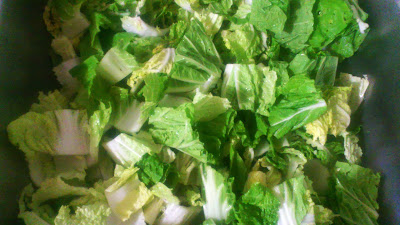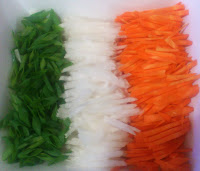I think this was when I first took interest in cooking this dish, Chili Con Carne. From the implication in the show, the dish was originally Texan in origin. So I went on ahead and, well, you guessed it, looked it up.PRIYA KOOTHRAPPALI:
Would you like some homemade chili?
SHELDON COOPER
Are there beans in it?
PRIYA KOOTHRAPPALI
Yes?
SHELDON COOPER
Then it's not chili. Real chili has no beans in it, but you're from a foreign land, so your ignorance is forgiven.
[Sheldon tries some of Priya's chili]
SHELDON COOPER
Mmmm, this is good... whatever it is.
Since the article is too long to quote, let me do a summary of how I understood it. Chili con Carne is a dish that had been used by American frontier settlers originally comprised of dried beef, suet and dried chili peppers pounded together to form bricks for them to easily boil it on the road. It then gained popularity around late 1800s where Mexican women sold them in downtown San Antonio around dusk by the bowl to passers by. So, Texas-born Sheldon Cooper is actually accurate with his details, as always, regarding Chili.
Inferring from his snide remark on how "Real chili has no beans in it" is also on target as the original version does not contain beans. The addition of beans dawned early in the 20th century when beans was associated as a staple to Tex-Mex cuisines. So Texan chili may, or may not contain beans and I believe the distinction is, that chili with beans is called "Chili Beans" and the all-meat version is the one dubbed "Chili"
Okay! Enough with the history lesson and on with the cooking!!! I adapted this Chili from Jamie Oliver's Good Old Chilli Con Carne Recipe (click here). Just a note... I used all fresh ingredients except for the spices and the beans which are dried. Nothing canned or frozen since my mom is all the rage with "whole food" thing.
 |
| Chili, just before the slow cook simmering part |
Ingredients:
1 medium sized bell pepper
2 red lady finger peppers
2 green lady finger peppers
2 medium sized onions
2 small heads garlic (not cloves, I mean the whole garlic head)
2 stalks celery
1 medium sized carrot
2 medium sized taro potato (to my beloved fellowmen... this is the gabing pangsigang >_<)
 |
| taro root |
1-2 cups dried red kidney beans
1/2 cup garbanzos (chick/ugly peas)
6 pcs medium sized tomatoes
1 heaped tsp chili powder
1 level tsp cumin powder
1 level tsp cinnamon powder
500-600 gm ground beef
2-3 tbsp cooking oil (olive/vegetable/palm/coconut)
salt and pepper to taste
Special Prep
3 days before the day you plan to cook your chilli, soak your dried beans in room temperature water with 2 tbsp of vinegar (organic or apple cider will do nicely). Just make sure that you let the water cover your beans completely with a margin above since beans usually swell up to 3 times their dried size. Don't panic if you see scum or foam forming in the surface and that it smells weird, it's fine, just leave it there for 48-72 hours. The scum formation are actually anti-nutrients like phytic acid that inhibits mineral absorption which can be detrimental to our health. Plus, soaking the beans eliminates the gassy aftermath of a bean based dish. Just make sure to rinse thoroughly before using.
Method
1. Chop the carrots, chilies, celery, onions and garlic. Chop them to bits.
2. Put all the veggies in a large casserole, add the oil then saute in medium heat till caramelized. Or until soft with little brown edges.
3. Meanwhile... drain the beans, the garbanzos (chick peas). Chop the taro and the tomatoes into half inch cubes. I forgot to take a picture of the taro and tomato huhuhu.
4. Back to the pot... Add the chili, cumin and cinnamon.
5. Add the ground beef. Saute.
6. Add the tomatoes, beans and peas. Add 1 cup of water. Stir. At this point, you will have to add salt or if you prefer, you can use fish sauce. This will be according to taste. By the way, try to make it a little bland since the stew will have to be reduced so water will be evaporating. There is a risk of a too salty chili if you salt it too much. Remember, you can always correct the taste right before serving.
7. Simmer till the beans are soft enough for your. This will also depend on your taste. Leave it a little longer if you want the beans to be really soft. This can be anywhere from 1 hour to 3 hours.
8. Serve with freshly cooked rice.
Note: This goes well with yogurt or cream cheese. So while it's piping hot, you can put a dollop of yogurt or cream cheese and blend it in. It adds to the creaminess of the whole dish.
And left overs can be devoured the next day. That is, if you have any :)
Serves: 6-8 people if eaten with rice
Happy weekend Y'all!



































